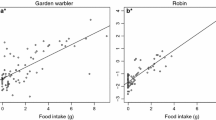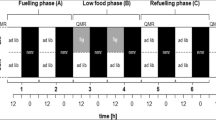Abstract
It has been argued that the body mass levels achieved by birds are determined by the trade-off between risks of starvation and predation. Birds have also been found to reduce body mass in response to an increased predation risk. During migration, the need of extra fuel for flights is obvious and crucial. In this study, migratory blackcaps (Sylvia atricapilla) were subject to an experimental stopover situation where the predation risk was manipulated by exposure to a stuffed predator. Blackcaps that perceived an imminent risk of predation increased their food intake and fuel deposition rate during the first period of stopover compared with a control group. The pattern of night activity indicates that birds that were exposed to the predator also chose to leave earlier than birds in the control group. Since there was no cover present at the stopover site, birds might have perceived the risk of predation as higher regardless of whether they were foraging or not. Under such circumstances it has been predicted that birds should increase their foraging activity. The findings in this study clearly indicate that birds are able to adjust their stopover behaviour to perceived predation risk.
Similar content being viewed by others
Author information
Authors and Affiliations
Additional information
Received: 8 January 1997 / Accepted after revision: 11 April 1997
Rights and permissions
About this article
Cite this article
Fransson, T., Weber, T. Migratory fuelling in blackcaps (Sylvia atricapilla) under perceived risk of predation. Behav Ecol Sociobiol 41, 75–80 (1997). https://doi.org/10.1007/s002650050366
Issue Date:
DOI: https://doi.org/10.1007/s002650050366




